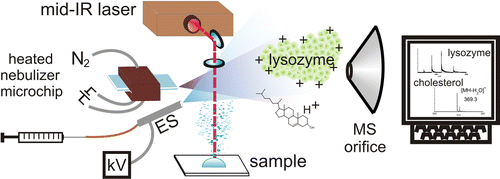Anu Vaikkinen, Bindesh Shrestha, Javad Nazarian, Risto Kostiainen, Akos Vertes, and Tiina J. Kauppila
Analytical Chemistry, 2012, 84 (3), pp 1630–1636
DOI: 10.1021/ac202905y | Impact factor (2010): 5.874
DOWNNLOAD | ONLINE
ABSTRACT

A heat-assisted laser ablation electrospray ionization (HA-LAESI) method for the simultaneous mass spectrometric analysis of nonpolar and polar analytes was developed. The sample was introduced using mid-infrared laser ablation of a water-rich target. The ablated analytes were ionized with an electrospray plume, which was intercepted by a heated nitrogen gas jet that enhanced the ionization of analytes of low polarity. The feasibility of HA-LAESI was tested by analyzing, e.g., naphtho[2,3-a]pyrene, cholesterol, tricaprylin, 1,1′,2,2′-tetramyristoyl cardiolipin, bradykinin fragment 1-8, and 1-palmitoyl-2-oleoyl-sn-glycerol. HA-LAESI was found better suited for low polarity compounds than conventional LAESI, whereas polar compounds were observed with both techniques. The sensitivity of HA-LAESI for the polar bradykinin fragment 1-8 was slightly lower than observed for LAESI. HA-LAESI showed a linear response for 500 nM to 1.0 mM solutions (n = 11) of verapamil with R(2) = 0.988. HA-LAESI was applied for the direct analysis of tissue samples, e.g., avocado (Persea americana) mesocarp and mouse brain tissue sections. Spectra of the avocado showed abundant triglyceride ion peaks, and the results for the mouse brain sections showed cholesterol as the main species. Conventional LAESI shows significantly lower ionization efficiency for these neutral lipids. HA-LAESI can be applied to the analysis of nonpolar and polar analytes, and it extends the capabilities of conventional LAESI to nonpolar and neutral compounds.